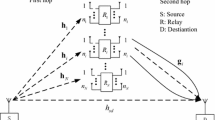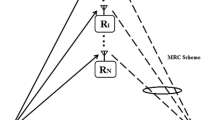Abstract
In this paper, we consider a cooperative communication system with differential modulation and relay-selection (DM–RS) in multi-relay networks, where the best relay is selected to forward the source node’s signal to the destination node with detect-and-forward (DetF) protocol. Unlike the conventional DM–RS–DetF scheme using phase shift keying (PSK), we propose a DM–RS–DetF scheme with quadrature amplitude modulation (QAM). Since the differential PSK scheme cannot be applied to the QAM constellations directly, we firstly develop the modulation and demodulation methods for the differential QAM scheme. Then, we derive a closed-form approximation and an upper bound of the symbol error rate for the DQAM–RS–DetF scheme over independent Rayleigh fading channels, by using the approximated signal-to-noise ratio of the equivalent relay link. Simulations results verify the validity of the analytical results and further show that when the modulation order \(M>8\) in Rayleigh fading channels, the DQAM–RS–DetF scheme outperforms the DPSK–RS–DetF scheme.





Similar content being viewed by others
Notes
In [16], the proposed MLC is given by Eq. (8), i.e., \({{z}_{m}}\left( n \right) \approx y_{{ SD}}^{\text{* }}\left( n-1 \right) {{y}_{{ SD}}}\left( n \right) \text{+ }\frac{{{\gamma }_{eq}}}{{{\gamma }_{{ RD}}}}y_{{ RD}}^{\text{* }}\left( n-1 \right) {{y}_{{ RD}}}\left( n \right) \). If we consider a noise free situation, combining Eqs. (1), (2) and (5) in [16], we can obtain \({{z}_{m}}\left( n \right) \approx {{\mu }_{{ SD}}}d\left( n \right) +{{\mu }_{eq}}\tilde{d}\left( n \right) \), where \({{\mu }_{{ SD}}}={{\left| {{h}_{{ SD}}} \right| }^{2}}, {{\mu }_{eq}}=\min \{ {{\left| {{h}_{{ SR}}} \right| }^{2}}, {{\left| {{h}_{{ RD}}} \right| }^{2}} \}\). This is the MLC we used in this paper.
References
Sendonaris, A., Erkip, E., & Aazhang, B. (2003). User cooperation diversity. Part I. System description. IEEE Transactions on Communications, 51(11), 1927–1938.
Sendonaris, A., Erkip, E., & Aazhang, B. (2003). User cooperation diversity. Part II. Implementation aspects and performance analysis. IEEE Transactions on Communications, 51(11), 1939–1948.
Nosratinia, A., Hunter, T., & Hedayat, A. (2004). Cooperative communication in wireless networks. IEEE Communications Magazine, 42(10), 74–80.
Yang, Y., Hu, H., Xu, J., & Mao, G. (2009). Relay technologies for WiMax and LTE-advanced mobile systems. IEEE Communications Magazine, 47(10), 100–105.
Laneman, J. N., Tse, D. N. C., & Wornell, G. W. (2004). Cooperative diversity in wireless networks: Efficient protocols and outage behavior. IEEE Transactions on Information Theory, 50(12), 3062–3080.
Bletsas, A., Khisti, A., Reed, D. P., & Lippman, A. (2006). A simple cooperative diversity method based on network path selection. IEEE Journal on Selected Areas in Communications, 24(3), 659–672.
Ibrahim, A. S., Sadek, A. K., Su, W., & Liu, K. J. R. (2008). Cooperative communications with relay-selection: When to cooperate and whom to cooperate with. IEEE Transactions on Wireless Communications, 7(7), 2814–2827.
Madan, R., Mehta, N., Molisch, A., & Zhang, J. (2008). Energy-efficient cooperative relaying over fading channels with simple relay selection. IEEE Transactions on Wireless Communication, 7(8), 3013–3025.
Laneman, J. N., & Wornell, G. W. (2003). Distributed space-time-coded protocols for exploiting cooperative diversity in wireless networks. IEEE Transactions on Information Theory, 49(10), 2415–2425.
Jing, Y., & Hassibi, B. (2006). Distributed space-time coding in wireless relay networks. IEEE Transactions on Wireless Communication, 5(12), 3524–3536.
Jing, Y., & Jafarkhani, H. (2007). Using orthogonal and quasi-orthogonal designs in wireless relay networks. IEEE Transactions on Information Theory, 53(11), 4106–4118.
Zhao, Y., Adve, R., & Lim, T. J. (2007). Improving amplify-and-forward relay networks: Optimal power allocation versus selection. IEEE Transactions on Wireless Communications, 6(8), 3114–3123.
Jing, Y., & Jafarkhani, H. (2009). Single and multiple relay selection schemes and their achievable diversity orders. IEEE Transactions on Wireless Communications, 8(3), 1414–1423.
Zheng, Z., Fu, S., Lu, K., Wang, J., & Chen, B. (2012). On the relay selection for cooperative wireless networks with physical-layer network coding. Wireless Networks, 18(6): 653–665.
Zhu, Y., Kam, P. Y., & Xin, Y. (2010). Differential modulation for decode-and-forward multiple relay systems. IEEE Transactions on Communications, 58(1), 189–199.
Yuan, J., Li, Y., & Chu, L. (2010). Differential modulation and relay selection with detect-and-forward cooperative relaying. IEEE Transactions on Vehicle Technology, 59(1), 261–268.
Gao, Y., Ge, J., & Han, C. (2011). Performance analysis of differential modulation and relay selection with detect-and-forward cooperative relaying. IEEE Communication Letters, 15(3), 323–325.
Benjillali, M., & Szczecinski, L. (2009). A simple detect-and-forward scheme in fading channels. IEEE Communication Letters, 13(5), 309–311.
Proakis, J. G. (2001). Digital communications (4th ed.). New York: McGraw-Hill.
Weber, W. I. I. I. (1978). Differential encoding for multiple amplitude and phase shift keying systems. IEEE Transactions on Communication, 26(3), 385–391.
Warrier, D., & Madhow, U. (2002). Spectrally efficient noncoherent communication. IEEE Transaction on Information Theory, 48(3), 651–668.
Wang, T., Cano, A., Giannakis, G. B., & Laneman, N. (2007). High-performance cooperative demodulation with decode-and-forward relays. IEEE Transaction on Communications, 55(7), 1427–1438.
David, H. A. (1970). Order statistics. Hoboken, NJ: Wiley.
Simon, M. K., & Alouini, M. S. (2005). Digital communications over fading channels (2nd ed.). Hoboken, NJ: Wiley.
Author information
Authors and Affiliations
Corresponding author
Additional information
This work was supported by the Fundamental Research Funds for the Central Universities (Grant No. K50511010005), the National Basic Research Program of China under Grant 2012CB316100, the 111 project (Grant No. B08038) and the National Natural Science Foundation of China (Grant Nos. 61001128, 61001207, 61101144 and 61101145). The authors gratefully acknowledge the Research in Motion (RIM) Corporation of Canada for financial support.
Appendix
Appendix
In this appendix, we will calculate the MSE of the CP estimation, i.e., Eq. (20) in Sect. 3. From the definition of the MSE,
Since \(h\sim { CN}\left( 0,\sigma _{h}^{2} \right) \), we have \(E\left[ {{\left| h \right| }^{4}} \right] =2\sigma _{h}^{2}\). Thus, the first term in (39) can be rewritten as
Using \(E[ {\mathbf{y }^{H}}\mathbf y ]=L{{\left| h \right| }^{2}} +L\sigma _{e}^{2}\), the second term in (39) becomes
In addition, using (18), the third term in (39) can be expanded as
Since the source symbols \({{s}_{1}},\ldots ,{{s}_{L}}\) are iid discrete random variables with \(E\left[ {{\left| {{s}_{l}} \right| }^{2}} \right] =1\), from (2) the first term in (42) can be calculated as
where \({{\nu }_{a}}=E\left[ {a}_{l}^4 \right] \). Using \(\mathfrak R \left( {{h}^{*}}{\mathbf{x }^{H}}\mathbf e \right) =\mathfrak R \left( {{h}^{*}} \right) \sum \nolimits _{k=1}^{L}\mathfrak{R \left( x_{k}^{*}e \right) }+\mathfrak I \left( {{h}^{*}} \right) \sum \nolimits _{k=1}^{L}\mathfrak{I \left( x_{k}^{*}e \right) }\), the \({{{ MSE}}_{{ CP}2}}\) in (42) becomes
Moreover, \({\mathbf{e }^{H}}\mathbf e =\sum \nolimits _{k=1}^{L}{\left( \mathfrak R {{\left( {{e}_{k}} \right) }^{2}}+\mathfrak I {{\left( {{e}_{k}} \right) }^{2}} \right) }\) confines the central Chi-square distribution with \(2L\) degrees of freedom, then \(E\left[ {{\left( {\mathbf{e }^{H}}\mathbf e \right) }^{2}} \right] =\left( L+{{L}^{2}} \right) \sigma _{e}^{4}\). Thus, the \({{MSE}_{CP3}}\) in (42) can be obtained as
Since \(E\left[ \mathfrak R \left( {{h}^{*}} \right) \right] =E\left[ \mathfrak I \left( {{h}^{*}} \right) \right] =0\), the \({ MSE}_{{ CP}4}\) and \({ MSE}_{CP5}\) are equal to zero. In addition, the \({{{ MSE}}_{{ CP}6}}\) in (42) can be calculated as
Substituting (43)–(46) into (42), the MSE of the CP estimation can be obtained as
Rights and permissions
About this article
Cite this article
Gao, Y., Ge, J. & Cong, W. Differential Quadrature Amplitude Modulation and Relay Selection with Detect-and-Forward Cooperative Relaying. Wireless Pers Commun 72, 1399–1414 (2013). https://doi.org/10.1007/s11277-013-1085-0
Published:
Issue Date:
DOI: https://doi.org/10.1007/s11277-013-1085-0




